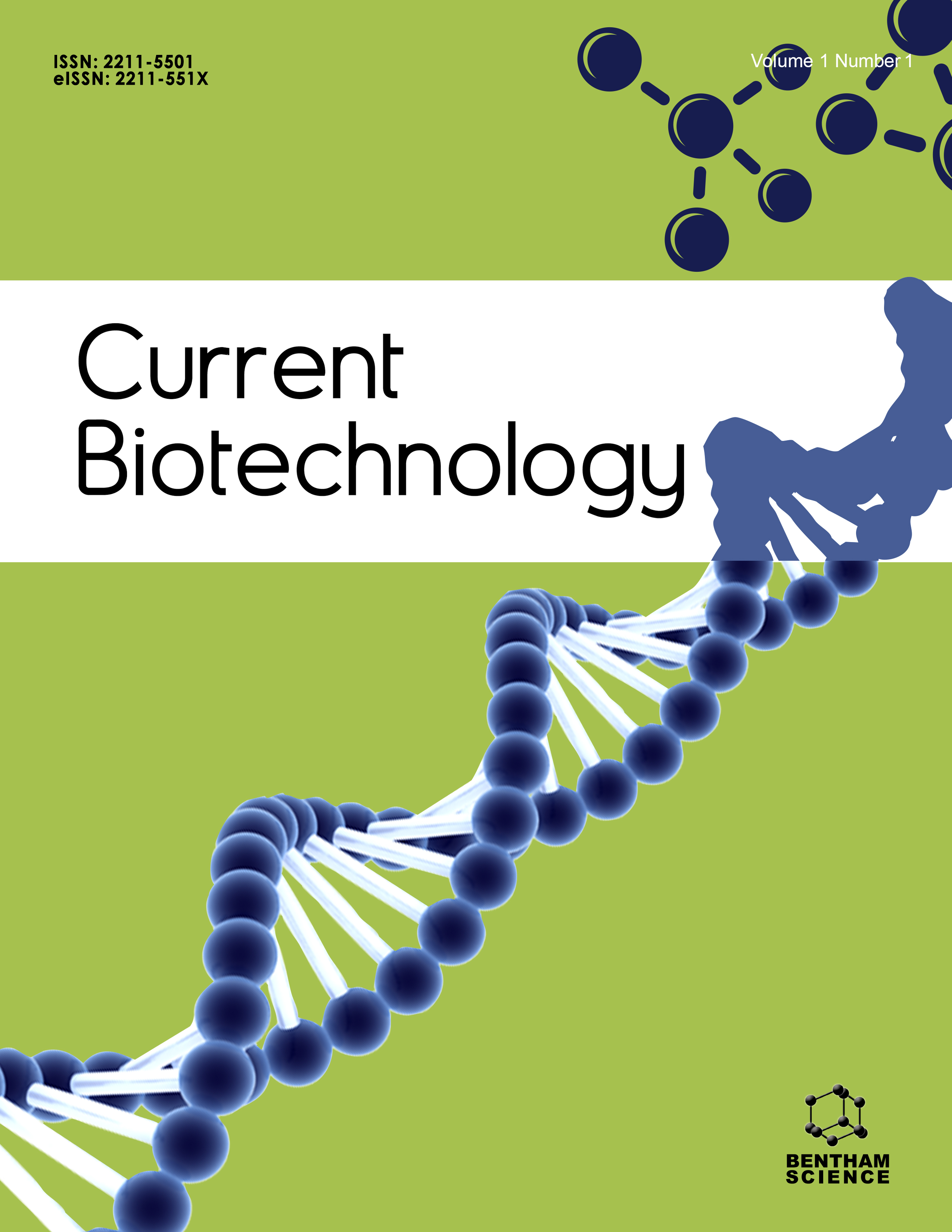- Home
- A-Z Publications
- Current Biotechnology
- Previous Issues
- Volume 6, Issue 4, 2017
Current Biotechnology - Volume 6, Issue 4, 2017
Volume 6, Issue 4, 2017
-
-
Aspergillus Biotechnology: An Overview on the Production of Hydrolases and Secondary Metabolites
More LessAuthors: Luis H. Souza Guimaraes and Patricia Nirlane da Costa SouzaBackground: Microorganisms such as filamentous fungi are important sources of enzymes and secondary metabolites with wide application in biotechnological processes conducted in different industrial areas. Aspergillus, one of the most important genera of filamentous fungi for this purpose, has been used as a model to understand different biological processes. Despite the existence of some pathogenic Aspergillus s Read More
-
-
-
Lipase Production from a Newly Isolated Aspergillus niger by Solid State Fermentation Using Canola Cake as Substrate
More LessBackground: Current studies about lipases production using agro-industrial residues and newly isolated microorganisms aimed at increasing economic attractiveness. Objective: The present study evaluated the lipase production from Aspergillus niger using canola cake as substrate and its extraction and characterization. Methods: Firstly, the microorganism was identified using sequencer ABI PRISM 3100 Genetic Analyzer. A Read More
-
-
-
Production of Lipases by a Newly Isolate of Aspergillus niger Using Agroindustrial Wastes by Solid State Fermentation
More LessBackground: Lipases are enzymes widely used in many industrial applications. However, its use can be increased by reducing costs of production, being important to this effort the screening of new microorganisms producing and the use of low cost culture mediums, such as agricultural residuals. Objective: To produce lipases using two new isolates of filamentous fungi in solid-state fermentation. Methods: The selection of Read More
-
-
-
Extraction of Tannase by the New Strain of Penicillium
More LessBackgrond: The aqueous two-phase systems (ATPS) have been used as the first purification step in enzyme industrial isolation. Such systems allow the removal of large amounts and different types of contaminants by a simple and economic unit operation. Objective: The tannase extraction was conducted through ATPS composed of polyethylene glycol (PEG) and sodium citrate salt (PEG/citrate). Method: A factorial design model ( Read More
-
-
-
Characterization of a Solvent-tolerant Manganese Peroxidase from Pleurotus pulmonarius and its Application in Dye Decolorization
More LessBackground: Manganese peroxidase (MnP) is a common extracellular ligninolytic peroxidase produced by Pleurotus spp. It catalyzes the H2O2-dependent oxidation of Mn2+ into highly reactive Mn3+, which in turn oxidizes phenolic and nonphenolic compounds including a large list of xenobiotics such as synthetic dyes. Objective: To purify and characterize the MnP of Pleurotus pulmonarius and to evaluate its capability Read More
-
-
-
Isolation of the Antibacterial Agent Viridiol from the Mangrove Endophytic Fungus Hypocrea virens, as Monitored by a Biologic Assay Against Escherichia coli and NMR Spectroscopy
More LessBackground: Endophytic fungi are considered a source of novel activities, compounds and biotechnological processes with great and underexplored potential. The aims of this paper were: a) to evaluate the antibiotic activity of mangrove endophytic fungi against the human pathogens Staphylococcus aureus, Salmonela typhi and Escherichia coli and against the phytopathogen Xantomonas axonopodis citri; b) to elucidat Read More
-
-
-
Biocatalytic Transformations of Organic Compounds by Brazilian Marinederived Fungi
More LessAuthors: Ana M. Mouad and Andre Luiz Meleiro PortoBackground: This review is intended to give an account of the knowledge about enzymatic reactions performed by brazilian marine-derived fungi. These biocatalysts can offer a range of enzymes capable to produce a large spectra of added value compounds. Screenings with varied species of marine-derived fungi presented active enzymes capable of performing the biotransformation of nitriles and epoxides, bioreduction of ca Read More
-
-
-
Natural and Engineered Defenses Against Plant Viruses
More LessAuthors: Lara-Simone Pretorius, Nasser Hussein, Anahid Al-Amery, Richard L. Moyle and Peer M. SchenkBackground: Plants live in a dynamic environment subjected to frequent pathogenic and environmental stresses and have evolved diverse self-defense pathways for their survival. Many of these defense responses are energy-intensive and antagonistic against each other to enable prioritization of strong targeted responses. Viruses cause significant damage in the agricultural and natural world. They are obligate intr Read More
-
-
-
Production and Optimization of Bacterial Cellulase Using Agricultural Cellulosic Biomass by Solid State Cultivation
More LessAuthors: Michael B. Osho, Pauline Nnebuogor Nwagala and Eniola Enitan OjoBackground: Biodegradation of lignocellulosic materials to monomeric sugars by the action of cellulolytic enzymes has recorded a significant value for industrial processes. These sugars can be converted to ethanol which is of great economic value to salvage the ever-increasing global dependence on fossil fuel and its gradual depletion. Exploitation of this cellulosic groundnut shell biomass possesses both significant indu Read More
-
-
-
Purification and Characterization of β-Glucosidase from Penicillium janthinellum Mutant EU2D-21
More LessAuthors: Anil K. Nagraj, Nutan Mhetras, Susan Liddell and Digambar GokhaleBackground: β-Glucosidases are terminal enzymes in cellulose hydrlysis which hydrolyze glycosidic bonds between two or more carbohydrates. Not much information is available on purification and characterization of β-glucosidase from Penicillium janthinellum. Here we report the purification and characterization of thermostable β-glucosidase from P. janthinellum mutant EU2D-21 produced under submerged conditions. Metho Read More
-
Most Read This Month
Article
content/journals/cbiot
Journal
10
5
false
en


